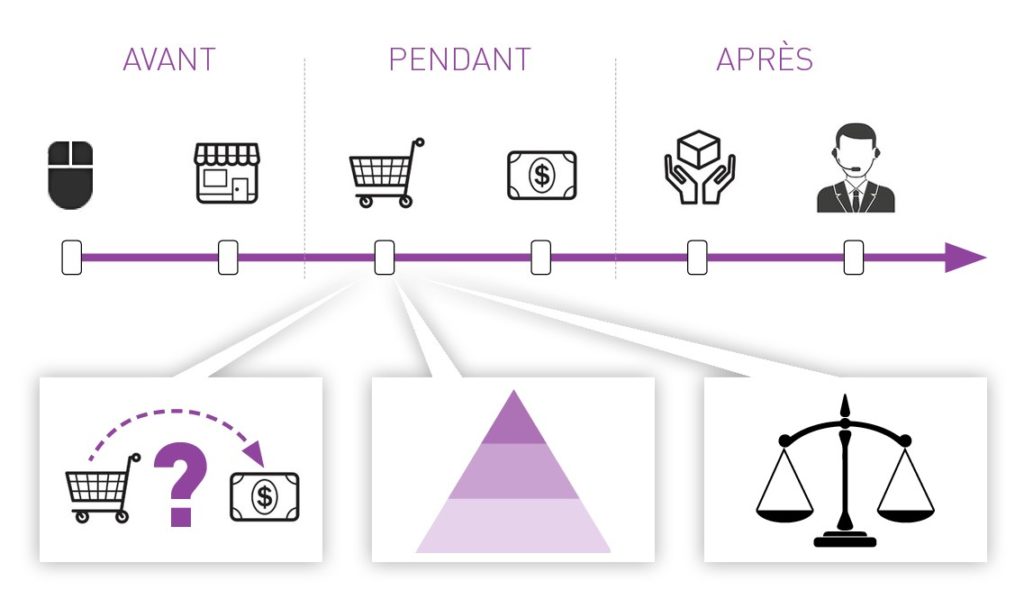Il nous a semblé tout naturel de partager ce point de vue avec nos propres lecteurs !
Quelle place tient le CRM dans votre approche client ?
Dominique Seguin : Le CRM est un incontournable de la relation client. Vous n’imagineriez pas aujourd’hui travailler sans smartphone, email et autres outils qui nous font tous gagner du temps ! Le CRM, application pour gérer la relation avec les clients permet bien d’autres choses que l’image technique et rédhibitoire qu’en ont les commerciaux : vous pouvez gérer vos relances, analyser vos chiffres, faire un emailing, stocker vos données clients pour les autres services de l’entreprise, évaluer votre performance commerciale…
Les commerciaux n’aiment pas les CRM car ils ont l’impression de devoir ressaisir leurs journées de travail pour remplir des tableaux que personne ne lit vraiment. Comme tout outil, il a ses contraintes, soyons réalistes, mais nous observons chez nos clients qu’aucun commercial confirmé ne se risque encore à gérer ses opportunités sur excel, ses relances sur un calepin, son prévisionnel sur une feuille blanche. L’enjeu d’appropriation par les équipes est donc particulièrement fort, et cela passe par une véritable perception des bénéfices associés !
Le sujet n’est pas nouveau (nous avions même réalisé et publié une étude en 2012 intitulée : “Commerciaux et CRM, pourquoi tant de haine?”), mais il reste d’actualité.
Notre conseil : saisissez-vous de cet outil comme d’une opportunité et tirez le meilleur parti de ses fonctionnalités !
A l’heure du tout digital, comment intéresser un prospect au téléphone sans paraître intrusif ?
Dominique Seguin : Les règles ne changent pas ! Si nous sommes intéressants, les gens seront intéressés ! Sinon ils nous le disent de manière très simple : « Je ne suis pas intéressé ».
Comment intéresser nos prospects ? En leur parlant de LEURS préoccupations. Soit nous avons trouvé de la matière disponible sur le web et ça servira d’accroche, soit nous amenons un ou deux sujets propres au marché ciblé et nous voyons si ça mord.
Ne vous fixez pas d’attentes incroyables concernant les taux d’appels transformés en rendez-vous : la moyenne est inférieure à 10%. Mais si vous vous préparez bien avec un pitch adapté, vous pouvez doubler votre performance.
Quelle place donnez-vous aujourd’hui au social media pour accroître ses ventes ?
Dominique Seguin : Disons que la fonction commerciale est au bord de l’uberisation !
50% du processus d’achat se fait sans recours au commercial. Le digital est devenu le premier concurrent de ce métier.
Comment voulez-vous espérer être plus pertinent et démonstratif qu’une vidéo 3D Youtube de 2mn qui met en valeur toutes les caractéristiques du produit avec une jolie musique, au moment où vous en avez besoin ? Il faut créer de la valeur ailleurs !
Soyez encore plus différenciant dans la compréhension des enjeux du client (arrêtons de le questionner sur ce qu’il veut, demandons lui pourquoi il le veut !), valorisez le coût de la situation actuelle et du dysfonctionnement constaté, et enfin restez présent à son esprit après avoir quitté son bureau.
Le social media est une opportunité fabuleuse de rester au contact du client après l’étape du rendez-vous.
Auparavant, la plaquette avait ce rôle mais désormais vous pouvez mettre en valeur votre parcours, votre expertise et votre actualité avec des outils actuels et interactifs.
Autrement dit, vous pouvez influencer, mettre en avant vos recommandations. Bref si c’est la fin de la plaquette, c’est le début du commercial 2.0 et ça rend le métier encore plus aiguisé et passionnant !
Au-delà des outils, qu’est-ce qui permet à un commercial de devenir un performer ?
Dominique Seguin : Méthode, méthode et méthode ! Au-delà du « talent » commercial réputé inné, c’est elle qui fait la différence. Dans la vente comme dans tout métier, la méthode est clé.
Croyez-vous qu’un boulanger se pose la question chaque nuit de comment faire du bon pain ? Non il suit toutes les nuits une recette éprouvée. C’est moins fatigant et il est certain de pouvoir servir ses clients le matin !
Les bons commerciaux ne réinventent pas la roue chaque jour en espérant avoir le bon sourire au bon moment ou la bonne formule ou le bon produit…
L’appât compte moins que le piège en lui-même ! C’est un peu raide comme mantra, mais c’est tellement vrai. Le piège, ce sont les techniques de vente répétées tous les jours pour améliorer constamment le geste.
De très bons commerciaux rompus à ces principes se cassent parfois les dents sur les phases de négociation… A quoi est-ce dû et comment l’éviter?
Dominique Seguin : Le principal écueil vient du manque de préparation. Entraînement difficile, guerre facile ! La majeure partie des commerciaux se préparent en serrant le frein à main. C’est l’échec assuré et le bon vieux recours à la faiblesse du commercial, la baisse des prix quémandée auprès de son manager.
On voit les bons commerciaux dans les virages, pas dans les lignes droites. La négociation n’a rien à voir avec la vente. Les grands négociateurs ne sont pas des vendeurs. Et l’inverse peut être vrai.
Un bon négociateur sera capable de créer un territoire nouveau pour les deux parties qui n’existe pas au début de la négociation, chacune ayant au départ en tête de protéger le sien.
Tout l’enjeu est de sortir de cette vision pour s’orienter vers la recherche d’une configuration nouvelle. Sinon, nous en restons à compter les points et souvent à ce jeu, c’est le client qui gagne !
Changeons le référentiel posé. Le vrai sujet qui compte pour un client, ce n’est pas de gagner la négociation, c’est de profiter au plus vite des bénéfices apportés par la solution convoitée et qui ont justifié la démarche d’achat, pour résoudre le problème identifié (machine coûteuse, service trop lent, process inefficace…)
Vous êtes consultant en Performance Commercial au sein de KESTIO depuis bientôt trois ans, quel bilan tirez-vous de ces années ?
Dominique Seguin : Après 18 ans d’opérationnel dans les ventes, du terrain au management d’un P&L de 180 Millions d’euros, je pensais que la bascule serait facile.
Je peux dire que ma meilleure décision après 6 mois a été de faire table rase pour apprendre un nouveau métier, un métier où on commence par réfléchir avant d’agir, où on étudie avant de décider.
Un métier qui consiste à aider nos clients à approcher leurs enjeux différemment car notre temps n’est pas le leur et c’est la richesse que nous leur apportons.
Un opérationnel n’a pas besoin d’un consultant pour assurer l’exécution quotidienne, il sait très bien le faire et est l’homme de l’art, nous ne connaîtrons jamais aussi bien que nos clients, leurs équipes, leur culture, leur histoire, leurs propres clients….
Le consultant apporte la capacité à rendre simple la complexité, à être le témoin des bonnes pratiques tous secteurs confondus, à identifier ce qui provoque l’échec, les dysfonctionnements, à trouver l’équilibre pour appréhender sereinement les blocages, à faire bouger les pratiques des collaborateurs par un véritable accompagnement dans la durée sans la pression du chiffre.
Nous aidons nos clients à retrouver de l’espace dans leur quotidien, pour mieux préparer l’avenir et permettre à leurs équipes de passer les caps pour continuer la course en tête sur leurs marchés.
Mon parcours d’opérationnel m’est d’une grande utilité car je comprends la vie de mes clients, je sais leurs doutes, leur volonté de réussir, l’énergie incroyable qu’ils mettent tous les jours pour atteindre leurs objectifs avec leurs équipes, souvent nous apportons le petit déclic qui fait tout bouger…
Peut-être aussi parce que chez KESTIO, nous ne nous prenons pas au sérieux et que ça fait toute la différence quand un Comex nous confie un sujet sérieux. Ils n’ont pas besoin de plus de complication que leur sujet ne leur en donne déjà !
Quelle est votre application mobile préférée ?
Dominique Seguin : J’adore Pocket car étant un infovore, j’aime manger du contenu en permanence. Entre newsletters, veille, blog, site d’actualités, comment trouver une application qui regroupe toute mes listes de lecture facilement et intuitivement ? Pocket le fait très bien, je ne peux plus m’en passer.
KESTIO accompagne les entreprises (de la PME au Grand Groupe) dans l’acquisition et la fidélisation de leurs clients, à travers une double expertise Performance Commerciale et Expérience Client.






